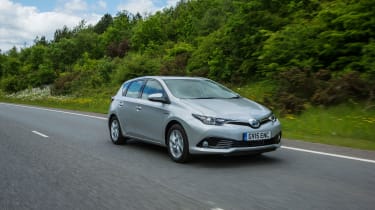Toyota Auris hatchback (2013-2019) - Engines, drive & performance
The Toyota Auris is a capable car, but you’re unlikely to enjoy driving it
Previously, the Toyota Auris had a surprisingly stiff suspension set-up for what was supposed to be a comfortable family car, but an update in mid-2015 remedied this by softening up the springs for a more cushioning ride. The facelift also added feel to the car's previously vague steering, but it's still no match for rivals like the SEAT Leon and Ford Focus when it comes to connecting your fingertips to the road.
The manual gearbox is light and precise, while its sixth gear boosts fuel economy and makes the Auris a quiet cruiser. And while they don't communicate back much of the driving experience, the Auris' light controls do at least make it stress-free and easy to operate.
Toyota Auris petrol engines
The basic 1.33-litre petrol can get the Auris from 0-62mph in 12.6 seconds, but it shows its age compared to hi-tech models such as the pricier Ford Focus EcoBoost. That 1.0-litre petrol engine not only claims better fuel economy, but also makes the Focus a quicker car.
Fortunately, Toyota added a more up-to-date (and, alas, more expensive) turbocharged 1.2-litre petrol to the Auris range as part of the mid-2015 update. This 114bhp engine brings the 0-62mph time down to 10.1 seconds and its punchy nature makes the car more fun to drive, too. It's also a four-cylinder, so it's quieter than the thrummy three-cylinder turbo engines in the Ford Focus and Peugeot 308.
Hybrid engine
The hybrid Auris completes the 0-62mph dash in 10.9 seconds and is also very quiet. Probably the biggest worry for the Auris Hybrid is the arrival of the Volkswagen Golf GTE. The top-specification Auris is considerably less expensive than the GTE, but it's also slower, less fun to drive and less economical.












